This article belongs to a series of three lectures "Changes and current challenges in Public Administration: a focus on the shifts in management modes of public service organizations, value generation logics of public service delivery, and performance management applied to governance"
Background and introduction
Most of the great events occurred in our society were probably achieved through a significant contribution of what we today would call public administration (Frederickson, Smith, Larimer, & Licari, 2016). For instance, the transition from feudal society to the extended nation-state in Europe (19th century) or the pursuit of both modern (e.g., democracy, freedom, safety, and justice) and contemporary goals (health care, education, equity, jobs) are example of the worth of Public Administration. In these and counting examples of societal achievements, core elements of public administration were found relevant.
Adopting a traditional perspective (Weber, 1952), foundations of public administration are:
- recognized formal authority;
- established laws and rules;
- separation of competences based on specialized expertise;
- hierarchy as a method for dealing with coordination;
- written records to establish continuity;
- separation between the organization and the persons holding positions in it;
- concern for organizational technologies.
The field of Public administration dates back to the 1887 with the publication of Woodrow Wilson’s founding essay “The Study of Administration”. Public Administration is more than 125 years old. In a certain way, public administration is a young adult.
There’s not a single theory of public administration. Public administration consists of a body of knowledge to which particular theories have contributed. At the outset was the expansion of bureaucracy and Taylorism. Later the rise of institutionalism portraying how public institutions shape the interaction of individuals and organizations in their political, social, and economic contexts. However, during the late 1980s, this language was replaced by decision theory, neo-classical economics, and public choice. By the end of 1990s, public administration is moving towards theory of cooperation, organizational theory, network theory, governance, stakeholder theory (Frederickson, 1999).

In this perspective, the field of public administration has undergone a number of shifts. Whereas public administration has traditionally been somewhat synonymous with government bureaucracy. Over the decades the emphasis on hierarchy, command-and-control, and top-down management has been replaced – passing through three dominant stages – by networks and collaboration (Osborne, 2010).
Indeed, the notion of authority, meant as the existence of a policy center characterizing the Weberian hierarchal model is being supplanted by leadership, networks, and governance capacity, enabling regimes of public policy and implementation (Emerson & Nabatchi, 2015).
Given this background, Public Administration has actually passed through three dominant modes (Osborne, 2006).
- a longer, pre-eminent one of Public Administration, from the early 1900 to the 1980s;
- a second mode, of the New Public Management, from the late 1980 to the 2000s;
- and, recently an emergent third one, of the Public Governance

Although these changes brought within Public Administration new theories and together have causing shifts of modes, some elements of the previous mode can be found in the subsequent.
The old public administration
For more than a hundred years, Western public sector institutions have been conceived according to what is usually known as the Old Public Administration. The Weberian ideas of bureaucracy[1] influenced the structure and the process of public institutions in Europe, while the thoughts of Woodrow Wilsons[2] and Frederick Taylor have led the public administration studies and practices in the United States. These two school of thoughts ruled public organizations until the early 1980s of the twentieth Century.
The Old Public Administration model was developed in the context of liberal constitutions and influenced by the work of Max Weber, Woodrow Wilsons and Frederick Taylor. Woodrow Wilsons is the father of Public Administration. His core idea was to make public administration a scientific discipline, so to enhance the understanding of methods thorough which improve efficiency and effectiveness in public policy design and implementation. To this end, during his time at the White House, he borrowed the “Principle of scientific Management” from Frederick Taylor (i.e., scientific sub-division of the work inside of an organization, training aligned with organizational aims, tasks-oriented procedure, managers-employee split). The idea of Weber, Wilsons and Taylor remained almost untouched until the end of the 1980s.
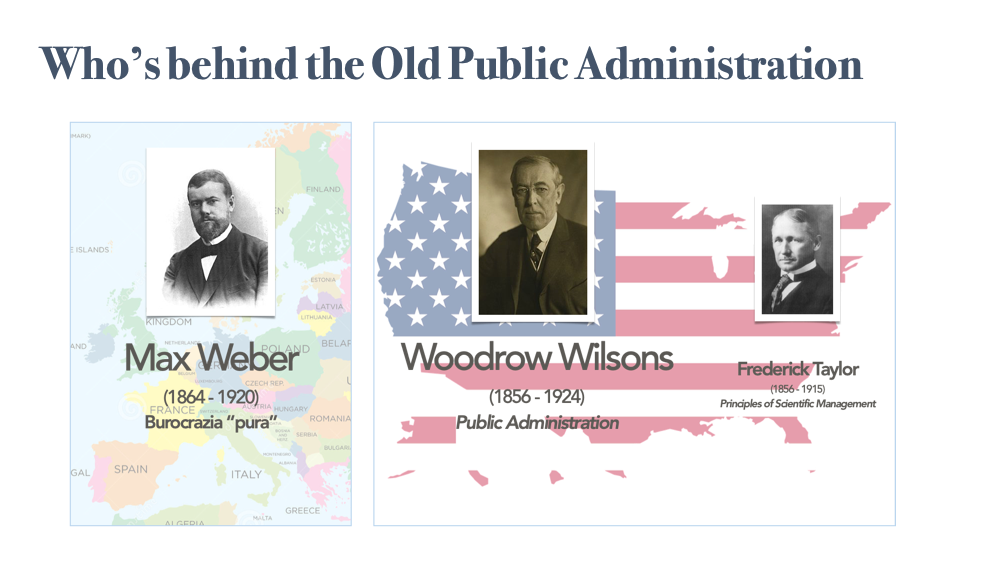
In Europe, Max Weber develops the concept of “Pure bureaucracy” which is based on the concept of:
- legal/rational authority,
- jurisdiction,
- hierarchy, and
- procedures.
The Old Public Administration model was configured as a hierarchical model, centered on the role of public organizations conceived as main actor within the society. According to this model, the legal/rational authority transfers the power from an inherited condition to a single person (e.g., the monarch) to a person who is charge of an organization, possibly through election from an inherited condition of a single person (e.g., the Monarch) to an elected official who is charge of an organization.
In order for an organization to act it has to exercise power within a framework of rules and procedures, thus making neutral the power of legal/rational authority. The jurisdiction associates each organization to a function (e.g., heath care) or to a location (e.g., a Municipality) that ensure a standard in public service delivery throughout the state. Hierarchy is conceived as coordination mechanisms that also guarantees impartiality and responsibility of the person at the top of the hierarchical structure. Following this scheme, services are delivered through processes strictly coded within rules and procedures. These elements make the public administration equal in front of citizens and support the pursuit of efficiency.
The assumption is that a pure bureaucratic model inherently ensures a superior efficiency, effectiveness, and equity given a rules-driven rational decision-making process. Also, a standardized and rigid structure makes treatments and services equals to all citizens.

Although the Old Public Administration shows differences between countries, different scholars (Dunleavy & Hood, 1994; Osborne, 2006; Pollitt, Van Thiel, & Homburg, 2007) have investigated its main features, as summarized in the table below.
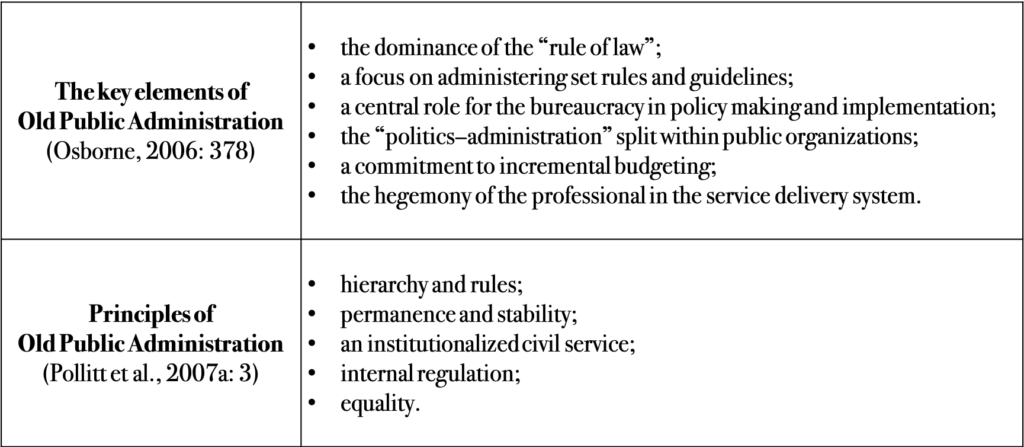
Besides the core features of the pure bureaucratic model, above commented, the Old Public Administration was committed to incremental budgeting under the pressure of competing politics, particularly during the age of welfare state, and to a professional service delivery system. In this perspective, bureaucracy can standardize administrative responses and deliver organizational effectiveness. To this end, crucial factors are: a hierarchical division of labor, administrative routines based on prescribed tasks, written records, merits-based appointments, full-time based employement.
By the end of the 1970s, socio-political and economic issues challenged the classical model of Old Public Administration. The leading role of government in promoting social changes and economic transformation come under fire because of the financial crisis and a number of limitations were underlined and pointed as main cause of financial shortage of governments. These include, market regulation, production rules, universal provision of public services. Also, the absence of any accountability of both politicians and managers, the authoritative power of bureaucracy and the spreading corruption of political parties, were identified as determinants for the poor performance of public institutions.
The old model was firmly politics in its nature (Denhardt & Denhardt, 2000), although there was a strong separation between politics and administration, where objectives and policies were decided by elected officials, and technical solutions identified by the civil servants (i.e., the administration); and citizens were almost exclusively considered as voters. Also, the Weberian model identified competitive elections as an accountability mechanism through which citizens might have selected their leaders. In these context, public services, were seen as a governmental remedies to market failures (Wolf, 1979) and delivered by public agencies, whose political mandate (Salamon, 2002) was the search for “[e]fficiency in government operations” (Bryson, Crosby, & Bloomberg, 2014: 447), though promoted through laws and rules.
In the early 1980s, a new set of ideas began to displace[3] the Old Public Administration. In other words, a new mode of Public Administration was therefore promoted. Public expectation was leading the emergence of alternative forms of service delivery and giving rise to a newmovement of reforms. Another season of changes in the substance and ideological setting of Public Administration occurred. Such dominant approach was lately termed as New Public Management(Bryson et al., 2014; Hood, 1991, 2001).
Driving forces of New Public Management
New Public Management emerged as a response to the rising complexity and fiscal crisis faced by governments around the world. NPM was a stamp which has been put on top of any Western countries reforms of public sector. “[T]he doctrines of public sector management encompassed by New Public Management have been variously described by different commentators” emphasizing that “there is some tension between the different intellectual streams that feed into the NPM” (Pollitt & Bouckaert, 2011: 10), with different words in Hood (1991, p. 4, 1995, p. 95).
The literature on NPM(Hood, 1991, 1995; Larbi, 1999; Pollitt & Bouckaert, 2011) identifies the forces which have driven changes in public sector. Although not completely new (Hood, 2001: 12554), contextual factors together with the development of new theories promoted as season of system level reforms. They also moved Public Administration as a discipline within business schools, in the Anglo-Saxon countries, while closer to political science and law studies in southern-Europe (Osborne, 2006: 379).
The pressure of financial shortage caused public institutions to adopt policy programs aimed at shrinking large organizations and at reducing the plethora of public institutions and agencies. The innovation in technology and information renovated and speed-up the relationships between organizations and staffs, also allowing world-wide communication. The emerging globalization boosted competition and claimed to abolishment of economic national borders, especially within European countries. The liberalization of several economic sectors promoted competition among organizations in service delivery and citizens’ demand for certain standards of quality of public services (Hughes, 2003; Hulme, Minogue, & Polidano, 1998).
Besides, a set of down-to-heart reasons (e.g., financial pressures, inefficiencies, the need of competition on public services, a quest for having a public sector more responsive and flexible to citizens needs), the development of new socio-economic theories have challenged fundamental principles of traditional public administration (Hughes, 2003). Different ideas, theories, and evidences pushed the shift from Old Public Administration to New Public Management. Hence, allotting some space to an overview of those theories may set the stage for an attempt to conceptualize the theoretical roots of New Public Management.

Primarily the Neoliberal view that held bureaucratic organizations accountable for inefficiencies in public service delivering (Lindblom, 1977) and the public choice theory by Niskanen and Buchanan that sharply criticized the bureaucratic model of public administration. These theories created a common belief about the ineffectiveness of public sector in favor of market institutions (Ferlie, Ashburner, Fitzgerald, & Pettigrew, 1996; Pollitt, 1990).
Several scholars identified the New Public Management as a product of New Institutional Economics (Aucoin, 1990; Dunleavy, 1991; Hughes, 2003; Osborne, 2010; Ostrom & Ostrom, 1971). Such a theory promoted the cutting of public services and the restructuring of its management through market-oriented solutions (Coase, 1984; Williamson, 1971, 1975). Several theories embrace New Institutional Economics (Richter, 2005). Those who influenced the most the theoretical strand of NPM are: the public choice (Samuelson, 1954; Tiebout, 1956), the transaction costs (Williamson, 1979), and the principal-agent theory (Niskanen, 1971).
The neoliberal idea of Von Hayek blamed public organizations responsible of inefficiencies in public service delivery. With his analysis of the “great crisis” he argued that the utmost concern for public sector organizations is to keep as low as possible the public debt, so to be responsive during an economic downturn.
Public choice theory disagreed with the classical model of “Administrative Behavior” according to which, though decision-makers have bounded rationality, they are inclined to pursue a theoretical optimum (Simon, 1976). On the contrary, Public choice theorists (Buchanan, 1976; Downs, 1967; Samuelson, 1954; Tiebout, 1956), endeavored to explain the behavior of politicians from a positivist perspective. According Public choice view they are actors guided by personal interests focused at maximizing utility, alike the free market. Similarly, bureaucrats try to increase their budgets and staffs to increase their power.
Transaction cost theory unpackaged the black box of policy implementation. Such a theory recognized production costs, and transactions costs. For instance, the time it takes for two or more partners to agree on a contract. This kind of costs stem from bounded rationality, asymmetry, moral hazard (self-interest), need of specific investments. By looking at these costs an organization may decide to use market or hierarchy as a strategy to reduce transactions and thus associated costs.
Principal-agent theory played a role in the shaping core feature of the New Public Management. The agency dilemma works when an agent (e.g., a person or an organization) has to take decisions on behalf of, or impacting on, the principal (Hakansson & Arrow, 1972; Pratt & Zeckhauser, 1985) The theory claims that between the principal and the agent a dilemma exists whenever an agent acts according to its own interests, therefore hindering those of the principal. Main concern of this theory was to solve two problems that can occur within organizations relationships. Specifically, a first kind of problem emerges when there’s a conflict between aims and interests of the principal and those of the agent; a second when it is not convenient, too expensive, or impossible for a principal to monitor and assess what an agent is doing (Fama, 2012). Therefore, the theory focuses on explaining what contracts governs efficiently principal-agent relationships characterized by self-interest, bounded rationality, moral hazard, goal conflict among members, and information asymmetry (Eisenhardt, 1989). The theory promoted the contracting out as a feasible solution to public service delivery.
Dunleavy (2005, p. 10) summarized the impacts of these driving forces on Public Administration. Three words: disaggregation, competition, and incentivization. An embraceable approach recognized New Public Management as “two level phenomena” (Dunleavy, 2005: 469). At the top level, the idea that the public sector can be improved by importing concepts, techniques, and values from the private sector, while – at a more operative level – the belief that New Public Management is a “bundle of specific concepts and practice” (Pollitt & Bouckaert, 2011: 10).
Framing New Public Management
NPM is “a chameleon-like and paradoxical creature” (Pollitt et al., 2007: 4), not owing universal characteristics (Ferlie & Geraghty, 2009, p. 431). There have been several attempts to delineate core elements of the New Public Management but the debate is not ended and the last word has not been said. NPM was defined as “a vision, and an ideology or a bundle of particular management approaches and techniques” (Larbi, 1999: 12). It was also defined as a “market-based public administration” (Lan & Rosenbloom, 1992: 535). NPM is “managerialism” (Pollitt et al., 2007: 1) or a result of “reinventing government” (Osborne & Gaebler, 1993: 1) or just a “post-bureaucratic model” (Barzelay, 2001: 153). In its most extreme form, NPM asserted the superiority of the private sector managerial techniques over those of public administration, by taking for granted that such techniques would have led improvements in the efficiency and effectiveness of public services delivering (Osborne, 2006: 379; Thatcher, 1993).
Key elements of NPM oriented reforms have been identified by (Osborne, 2006: 379)
- Private-sector management practices.
- Hands-on management.
- Arm’s length organizations.
- Policy implementation is organizationally distanced from the policy makers (as opposed to the ‘inter-personal’ distancing of the policy – administration split within PA).
- Focus on the entrepreneurial role of politics.
- Inputs and output control.
- Performance management and evaluation.
- Service unit-based cost accounting.
- The use of markets, competition and contracts for resource allocation and service delivery within public services.

In a nutshell, “the strength of NPM has been in its ability to address precisely the complexities of this black box, though which an equally irritating tendency to see the public policy process as simply a ‘context’ within which the essential task of public management takes place” (Osborne, 2006: 380).
Concerning the limitations, NPM promoted “decentralization, competition, and incentivization” (Dunleavy, Margetts, Bastow, & Tinkler, 2006: 470). Decentralization gave rise to a proliferation of agencies, lack of coordination, and sometimes inconsistency and incoherence among policy programs (Halligan, 2010; Pollitt & Talbot, 2004) putting this shortly: it has caused policy fragmentation. Also, NPM reforms have advanced the autonomy argument, by stressing structural devolution, and also have increased the distance between executive and politicians (Christensen, Lie, & Lægreid, 2008). Further, reforms imported outdated management techniques from private sector and these were adopted without being tailored to the specific context through top-down reforms. Lastly, critical limitations of NPM were found in its intragovernmental focus of performance management mainly based on input and output measurement (Osborne, 2006) and in the missed promise of increased accountability.
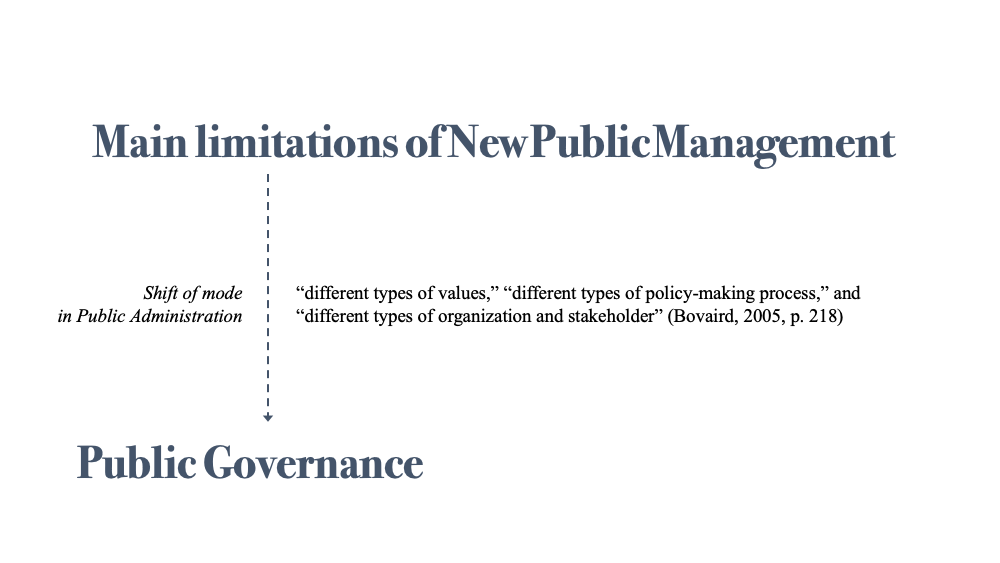
As a consequence of these limitations, studies on Public Administration began to integrate “different types of values,” “different types of policy-making process,” and “different types of organization and stakeholder” (Bovaird, 2005: 218). All of them were posing the need for a new mode of Public Administration: the Public Governance.
The new Public Governance
The NPM has replaced the Old Public Administration as prominent modes of Public Administration and some elements of the old mode remained in place (Hood, 1995; Kickert, 1997), some of them are present even after the raise of Public Governance (Osborne, 2010).
In the attempt to tackle main limitations and pitfalls of NPM-oriented reforms, the need for a holistic approach to address societal issues has emerged (Bouckaert, Peters, & Verhoest, 2010). Several authors have developed conceptual frameworks aiming at understanding what changes were occurring in the practice of management of public sector organizations (Frederickson, 2009; Jones, Hesterly, & Borgatti, 1997; Kickert, 1993; Kooiman, 1993; Osborne, 2006; Provan & Kenis, 2007; Rhodes, 1996). Scholars have termed the traits of these new network relations mostly as governance, public governance, network governance, and new public governance and they have inspired and motivated a long-standing theoretical debate in the field (Frederickson, 2009; Klijn, 2008; Osborne, 2010; Pestoff, Brandsen, & Verschuere, 2013; Rhodes, 1996). Indeed, since the late 1990s Public Governance has been a prominent subject in public management studies (Frederickson, 2009: 283). It has been explored with manifold roots of interest (Bovaird, 2005), owing to a considerable prior theoretical and/or ideological baggage (Osborne, 2006: 381).
In the attempt to devise a meaningful definition of governance, authors as well as scientific institutes come up with several of explanations of governance.
These include:
- governance is the way in which stakeholders interact with each other in order to influence the outcomes of policies (Bovaird & Löffler, 2009: 7);
- governance as “self-organizing inter-organizational networks” that function both with and without government to provide public services (Kickert, 1993: 199);
- governance is “about managing networks.” Governance as “minimal state, socio-cybernetic system and self-organizing networks” (Rhodes, 1997: 53);
- Frederickson (1999, p. 702) argued that “public administration is steadily moving […] toward theories of cooperation, networking, governance, and institution building and maintenance”;
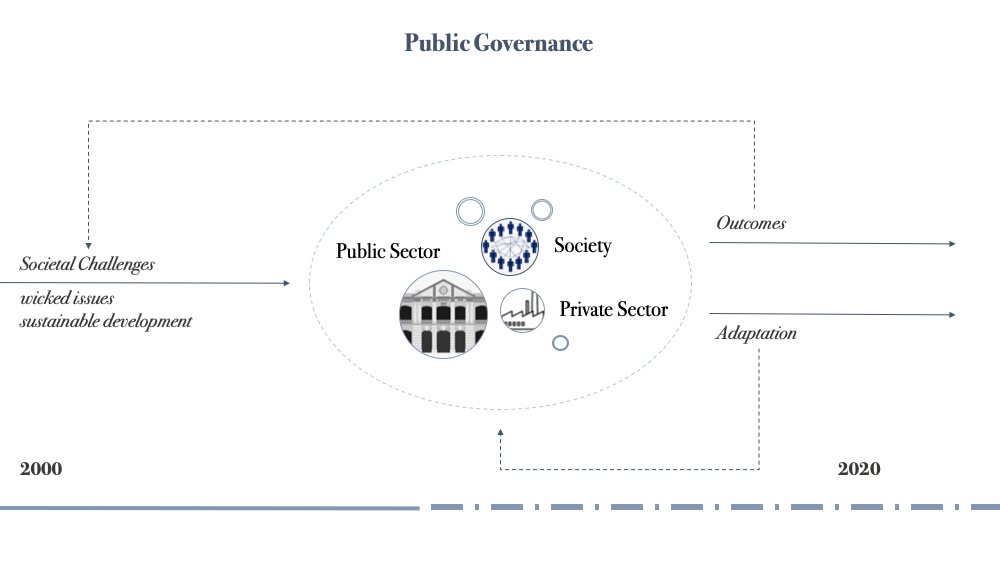
These definitions provide main features of Public Governance and attempts to mitigate the limits of the NPM model. It is a mode a process of decision-making in the public sphere with an inter-institutional perspective on policy design and implementation.

Governance has promoted coordination and collaboration between the public and private sector and has allowed Public Administration to experience new effective ways to satisfy public needs (Borgonovi, 2002). To this end, research and practice have placed greater emphasis on the network relationships, stakeholders’ engagement, and on the effectiveness of public services in terms of output and outcomes at both users and community levels.
Governance requires collaborative forums through which public leadership can build trust, manage conflict, and outline robust policy. (Crosby and Bryson 2010). Collaborative governance regimes (Emerson and Nabatchi 2015a) may align policy design at organizational and interinstitutional level. In fact, participant organizations are expected to tune their plans, activities, and targets with the goals and policies outlined with other stakeholders at macro (national and local policies) or policy field level (e.g., a specific sector). At the same time, effective collaborative governance requires that policy outcomes are continuously measured. This is also an important part for effectively addressing societal needs and political demands, as well as pursuing the adaptation of the governance structure through learning and mutual “knowledge transfer” (Koliba, Meek, and Zia 2011, 120).
Conclusion
To conclude, table 2 recaps main traits of three modes of Public Administration
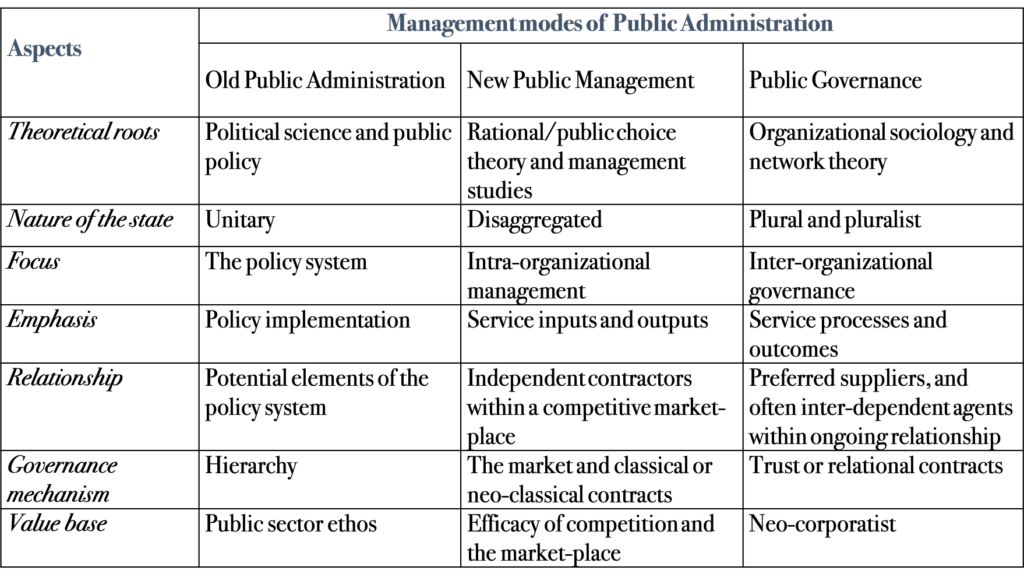
Old Public Administration is rooted in political science studies and deals with a unitary view of state in which policy making and implementation are managed by the central government through a bureaucratic model. It assumes the model as effective by natures since prescribed by the law. Efficiency is rather pursued through the respect of procedure to which employees and organizations have to comply with. Those rules decided upstream by elected and implicitly assumed, accountable politicians. Hierarchy is the key coordination mechanism for Public Administration.
By comparison, the NPM is a child of neo-classical economics and particularly of rational/public choice theory. It proposes an agencyfication and privatization of public bodies and policy implementation is pursued through individual service units, ideally in competition with each other. NPM focus is on intra-organizational processes and performance management emphasizes the economy and efficiency of service delivery.
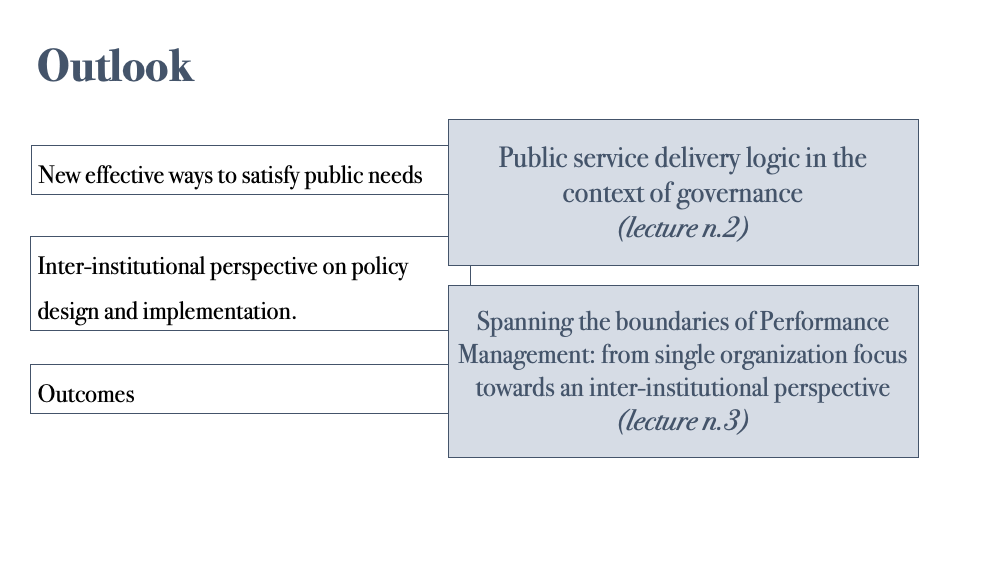
Lastly, Public Governance was influenced by organizational sociology and network theory (Haveri, 2006; Osborne, 2006), and particularly by the work of Ouchi (1980), and the organizational studies of Williamson (1981), and more recently by those of Powell (1990) and Tsai (2000). It suggests a plural state where multiple interdependent actors contribute to the delivery of public services. The ascent of governance, as a dominant mode in Public Administration uncovers two relevant areas of research which are covered by the second and the third lecture, respectively. The second lecture investigates current debate on the logic behind public service delivery with a focus public value improvement; the third lecture deals with the role of Performance Management as an effective method to support the governance of a policy field.
Presentation and teaching notes

Presentation and theaching notes are licensed under a Creative Commons Attribution-NonCommercial-ShareAlike 4.0 International License.
[1] For a detailed discussion of the old classic public administration see: Waters and Waters. 2015. Weber’s rationalism and modern society new translations on politics, bureaucracy, and social stratification. Basingstoke: Palgrave Macmillan
[2] Woodrow Wilson is widely recognized one of the field’s founders, along with Max Weber and Frederick Taylor. He firstformally characterized Public Administration in 1887 with “The Study of Administration”. Although Wilson indicates in the article that colleges were already teaching administration in the 1880s, this was considered a sub-field of political science. Wilson argued that it should be treated as its own field of study, with public administrators being directly responsible to political leaders. He believed that politicians should be accountable to the people and that political administration should be treated as a science and its practitioners given authority to address issues in their respective fields (see Hood. 2000. The Art of the State: Culture, Rhetoric, and Public Management: Clarendon Press).
[3] A crucial work – and also a best seller book – published in 1993 was Reinventing Government. How the entrepreneurial spirit is transforming the public sector (Osborne & Gaebler, 1993). Such a book suggested ten principles that are intended as a roadmap for any (entrepreneurial) government.
References
- Aucoin, P. 1990. Administrative Reform in Public Management: Paradigms, Principles, Paradoxes and Pendulums. Governance. https://doi.org/10.1111/j.1468-0491.1990.tb00111.x.
- Barzelay, M. 2001. The New Public Management: Improving Research and Policy Dialogue. University of California Press. https://books.google.it/books?id=8xqYFPAXNZIC.
- Borgonovi, E. 2002. Principi e sistemi aziendali per le amministrazioni pubbliche. Milano: EGEA. https://books.google.it/books?id=ADM5AAAACAAJ.
- Bouckaert, G., Peters, B., & Verhoest, K. 2010. The Coordination of Public Sector Organizations: Shifting Patterns of Public Management. Palgrave Macmillan UK. https://books.google.it/books?id=g1-8PwAACAAJ.
- Bovaird, T. 2005. Public governance: balancing stakeholder power in a network society. International Review of Administrative Sciences, 71(2): 217–228.
- Bovaird, T., & Löffler, E. 2009. Public management and governance (2nd ed.). London: Routledge.
- Bryson, J. M., Crosby, B. C., & Bloomberg, L. 2014. Public value governance: Moving beyond traditional public administration and the new public management. Public Administration Review. https://doi.org/10.1111/puar.12238.
- Buchanan, J. M. 1976. The limits of liberty: between anarchy and leviathan. Chicago, IL: Chicago University Press.
- Christensen, T., Lie, A., & Lægreid, P. 2008. Beyond new public management: agencification and regulatory reform in Norway. Financial Accountability & …, 24(1): 15–30.
- Coase, R. H. 1984. The New Institutional Economics. Zeitschrift Für Die Gesamte Staatswissenschaft / Journal of Institutional and Theoretical Economics, 140(1): 229–231.
- Denhardt, R. B., & Denhardt, J. V. 2000. The new public service: Serving rather than steering. Public Administration Review, 60(6): 549–559.
- Downs, A. 1967. Inside bureaucracy. Boston: Little, Brown.
- Dunleavy, P. 1991. Democracy, Bureaucracy and Public Choice. London: Routledge. https://doi.org/https://doi.org/10.4324/9781315835228.
- Dunleavy, P. 2005. New Public Management Is Dead–Long Live Digital-Era Governance. Journal of Public Administration Research and Theory, 16(3): 467–494.
- Dunleavy, P., & Hood, C. 1994. From old public administration to new public management. Public Money & Management, 14(3): 9–16.
- Dunleavy, P., Margetts, H., Bastow, S., & Tinkler, J. 2006. New public management is dead—long live digital-era governance. Journal of Public Administration Research and Theory, 16(3): 467–494.
- Eisenhardt, K. M. 1989. Agency Theory: An Assessment and Review. Academy of Management Review. https://doi.org/10.5465/amr.1989.4279003.
- Emerson, K., & Nabatchi, T. 2015. Collaborative governance regimes. Washington, DC: Georgetown University Press.
- Fama, E. 2012. Agency problems and the theory of the firm. The Economic Nature of the Firm: A Reader, Third Edition. https://doi.org/10.1017/CBO9780511817410.022.
- Ferlie, E., Ashburner, L., Fitzgerald, L., & Pettigrew, A. 1996. The New Public Management in Action. https://doi.org/10.1093/acprof:oso/9780198289029.001.0001.
- Ferlie, Ewan, & Geraghty, K. J. 2009. Professionals in Public Service Organizations: Implications for Public Sector “Reforming.” In E Ferlie, L. E. Lynn, & C. Pollitt (Eds.), The Oxford handbook of public management. Oxford University Press. https://doi.org/10.1093/oxfordhb/9780199226443.003.0019.
- Frederickson, H. G. 1999. The repositioning of American public administration. PS: Political Science & Politics, 32(04): 701–712.
- Frederickson, H. G. 2009. Whatever Happened to Public Administration?: Governance, Governance Everywhere. In E. Ferlie, L. E. Lynn, & C. Pollitt (Eds.), The Oxford handbook of public management. Oxford, UK: Oxford University Press. https://doi.org/10.1093/oxfordhb/9780199226443.003.0013.
- Frederickson, H. G., Smith, K. B., Larimer, C. W., & Licari, M. J. 2016. The public administration theory primer. (W. Press, Ed.). Boulder, US. http://site.ebrary.com/id/11077361.
- Hakansson, N. H., & Arrow, K. J. 1972. Essays in the Theory of Risk-Bearing. The Journal of Finance. https://doi.org/10.2307/2978877.
- Halligan, J. 2010. Post-NPM responses to disaggregation through coordinating horizontally and integrating governance. In P. Lægreid & K. Verhoest (Eds.), Governance of public sector organizations: 235–254. Springer.
- Haveri, A. 2006. Complexity in local government change: Limits to rational reforming. Public Management Review, 8(1): 31–46.
- Hood, C. 1991. A Public Management for All Seasons? Public Administration, 69(1): 3–19.
- Hood, C. 1995. The “new public management” in the 1980s: Variations on a theme. Accounting, 20(2–3): 93–109.
- Hood, C. 2001. Public Management, New. International Encyclopedia of the Social & Behavioral Sciences. Oxford: Pergamon.
- Hughes, O. E. 2003. Public Management and Administration, Third Edition: An Introduction (3d ed.). New York: Palgrave Macmillan. https://books.google.it/books?id=fViwQgAACAAJ.
- Hulme, D., Minogue, M., & Polidano, C. 1998. Beyond the New Public Management: Changing Ideas and Practices in Governance. Cheltenham: Edward Elgar Publishing.
- Jones, C., Hesterly, W. S., & Borgatti, S. P. 1997. A general theory of network governance: Exchange conditions and social mechanisms. Academy of Management Review. https://doi.org/10.5465/AMR.1997.9711022109.
- Kickert, W. J. M. 1993. Complexity Governance and Dynamics: Conceptual Explorations of Public Network Management. In J. Kooiman (Ed.), Modern governance: new government-society interactions. London: SAGE.
- Kickert, W. J. M. 1997. Public governance in The Netherlands: an alternative to Anglo‐American ‘managerialism.’ Public Administration, 75(4): 731–752.
- Klijn, E. H. 2008. Governance and Governance Networks in Europe. Public Management Review, 10(4): 505–525.
- Kooiman, J. 1993. Modern governance: new government-society interactions. London: Sage.
- Lan, Z., & Rosenbloom, D. H. 1992. Editorial: public administration in transition? Public Administration Review, 52(6): 535–537.
- Larbi, G. A. 1999. The new public management approach and crisis states.
- Lindblom, C. E. 1977. Politics and markets: the world’s political economic systems. Basic Books. https://books.google.nl/books?id=jihHAAAAMAAJ.
- Niskanen, W. A. 1971. Bureaucracy and Representative Government. Chicago, IL: Aldine-Atherton. https://books.google.it/books?id=dOYe1ld9F1QC.
- Osborne, & Gaebler, T. 1993. Reinventing Government: How the Entrepreneurial Spirit is Transforming the Public Sector. Plume. https://books.google.it/books?id=7qyp_EcJuZoC.
- Osborne, S. 2006. The new public governance? Public Management Review, 8(3): 377–387.
- Osborne, S. 2010. The new public governance? Emerging perspectives on the theory and practice of public governance. London: Routledge.
- Ostrom, V., & Ostrom, E. 1971. Public choice: A different approach to the study of public administration. Public Administration Review, 31(2): 203–216.
- Ouchi, W. G. 1980. Markets, Bureaucracies, and Clans. Administrative Science Quarterly, 25(1): 129–141.
- Pestoff, V., Brandsen, T., & Verschuere, B. 2013. New Public Governance, the Third Sector, and Co-Production. Taylor & Francis. https://books.google.it/books?id=ZqxWVX8U7SAC.
- Pollitt, C. 1990. Managerialism and the Public Services: The Anglo-American Experience. Cambridge, MA: Basil Blackwell. https://books.google.it/books?id=0oB9QgAACAAJ.
- Pollitt, C., & Bouckaert, G. 2011. Public Management Reform: A Comparative Analysis. Oxford, UK: Oxford University Press. https://books.google.it/books?id=E0fdN3KiPmgC.
- Pollitt, C., & Talbot, C. 2004. Unbundled government: a critical analysis of the global trend to agencies, quangos and contractualisation. London: Routledge.
- Pollitt, C., Van Thiel, S., & Homburg, V. 2007. New Public Management in Europe: Adaptation and Alternatives. Basingstoke, UK: Palgrave Macmillan UK. https://books.google.it/books?id=UxiFQgAACAAJ.
- Powell, W. 1990. Neither market nor hierarchy. Research in Organizational Behavior, 12: 295–336.
- Pratt, J. W., & Zeckhauser, R. J. 1985. Principals and Agents: The Structure of Business. Harvard Business School Press. https://doi.org/10.1016/0165-1765(90)90005-L.
- Provan, K. G., & Kenis, P. 2007. Modes of Network Governance: Structure, Management, and Effectiveness. Journal of Public Administration Research and Theory, 18(2): 229–252.
- Rhodes, R. A. W. 1996. The New Governance: Governing without Government. Political Studies, 44(4): 652–667.
- Rhodes, R. A. W. 1997. Understanding governance: Policy networks, governance, reflexivity and accountability. Buckingham, PA: Open University Press.
- Richter, R. 2005. The New Institutional Economics: Its Start, its Meaning, its Prospects. European Business Organization Law Review. https://doi.org/10.1017/S1566752905001618.
- Salamon, L. M. 2002. The tools of government: A guide to the new governance. USA: Oxford University Press.
- Samuelson, P. A. 1954. The pure theory of public expenditure. The Review of Economics and Statistics, 36(4): 387–389.
- Simon, H. A. 1976. Administrative behavior: a study of decision-making process in administrative organization (Second). New York: The Free Press.
- Thatcher, M. 1993. The Downing Street years. HarperCollins. https://books.google.no/books?id=Ar0Yvc3-ukAC.
- Tiebout, C. M. 1956. A Pure Theory of Local Expenditures. Journal of Political Economy. https://doi.org/10.1086/257839.
- Tsai, W. 2000. Social capital, strategic relatedness and the formation of intraorganizational linkages. Strategic Management Journal, 21(9): 925–939.
- Weber, M. 1952. The essentials of bureaucratic organization: an ideal-type construction. In R. K. Merton (Ed.), Reader in bureaucracy: 18–27. Glencoe, Ill: Free Press.
- Williamson, O. E. 1971. The Vertical Integration of Production: Market Failure Considerations. American Economic Review. https://doi.org/10.2307/1816983.Williamson, O. E. 1975. Markets and hierarchies : analysis and antitrust implications. London: Free Press.
- Williamson, O. E. 1979. Transaction-Cost Economics: The Governance of Contractual Relations. The Journal of Law and Economics. https://doi.org/10.1086/466942.
- Williamson, O. E. 1981. The economics of organization: The transaction cost approach. American Journal of Sociology, 87(3): 548–577.
- Wolf, C. 1979. A Theory of Nonmarket Failure: Framework for Implementation Analysis. The Journal of Law and Economics, 22(1): 107–139.
2 comments
This article is very useful for the university students
I teach in an MPA program and ask students to review the major public administration paradigms before we discuss their MPA project proposal. This is wonderful article. I will be adding it to the list I provide to my students. Grazie!
Laurie Buonanno, PhD – State University of New York, Buffalo State University